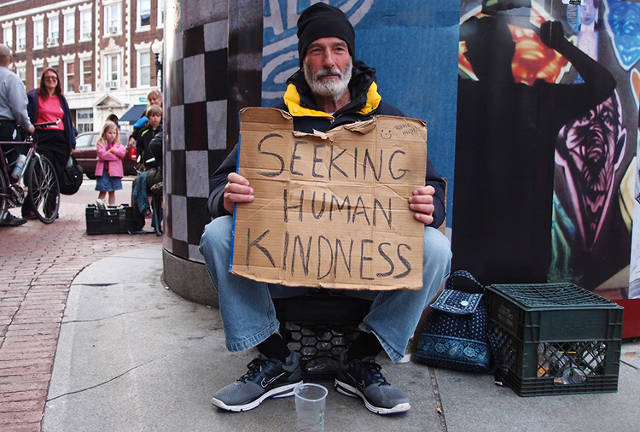An aggressive sign of an affluent society can usually be gauged by its invidious misuse of its privilege. Poverty is deemed necessary, and the rich must try to understand it. To be privileged is to be guilty, a tickling of the conscience as the pennies pile up and the assets grow; and from that premise, efforts must be made to give shape to the forgotten, and, in most cases, the invisible.

To be guilty is a spur for works that supposedly highlight those nagging reasons for feeling guilty. You might supply donations. You can become a philanthropist. You can join a charity. Obscenely, you can become a creature of mocking persuasion, a person of pantomime: you can assume the position of a poor person, a homeless person, and pretend to be him. And let it be filmed.
“When I was given the opportunity to spend 10 days experiencing different forms of homelessness for an SBS documentary, I jumped at the chance to understand more about a crisis that now sees more than 116,000 Australians homeless on any given night.” So go the words of veteran thespian Cameron Daddo, a person who never explains how understanding Sydney’s poverty leads to results, other than spending time on the screen and proving rather awkward to boot.
The individuals involved in the tawdry Australian spectacle Filthy Rich & Homeless have various reasons for participating. They have a chance, not merely to appear before the cameras, but to explore another part of Sydney. What matters for Skye Leckie is the anger of authenticity. Socialite that she is, she does not believe that her participation in the venture is “poverty porn” despite being the very same creature who benefits from having a good quotient of poor around. “Those who say it’s stunt TV are being totally ignorant to the homeless situation out there.” This is a delicious way of self-justification, a positioned blow to excuse how her exploitation of a social condition is entirely justified by a mysterious, holy insight. Her pantomime, in other words, is heralded as genuine.
Benjamin Law, author and very much an identity beacon (those things help these days), played the cool cat. In such ensembles, it’s always good to have the confidently composed, the person who won’t fall for the pathos of the show. “I went to Filthy Rich and Homeless being adamant that it was only 10 days, and that I wasn’t going to cry – I felt it’d almost be insulting to people who were actually homeless.” So goes his justification for actually participating in the project: he would hold firm, stay calm, keep his tear ducts dry. “But when it’s demonstrated that this could easily be a family member, and someone you love, I couldn’t not be affected.”
The show is sugary fodder for social media masturbation, an ever so prodding tease for those who feel pangs of stirring guilt. Nonsense about “genuine compassion” and “empathy” whirl through the chattersphere, with a disconcerting gurgle of approval at the program. The implication is clear: like true porn, it produces a release, an orgiastic sensation. The poor are sociological wank fodder. In the aftermath is the little death, or should be. Such programs float on the froth of sentiment, and last longer than they should.
There are shades of the carnivalesque, as Michael Bakhtin called it, in this exercise. The tradition of the carnival, he explained, suggested alternate worlds, inverted ones where social orders might, just temporarily, be suspended. The performer, and the audience, would become one. Communal dialogue might emerge. But the participants will eventually go home; the nobility will revert to their high standing, and the poor will undress and return to their squalid, putrid existence.
Feudalism and tribalism may have made their official exit in the historical textbooks, but we still find stirrings of old custom in the media industry. The poor are there to be mocked; the vulnerable are there to be, in some form, exploited. Gone is the exaggerated chivalric code, as meagre as it was (keeping people in place), and the presumption of charity. In its place is the clawing, scraping urge of the media moguls and networks keen to capitalise upon a condition, a disability, a drawback. Poverty is visual and lucrative for all – except the impoverished.
An obvious flaw in this project – several wealthy members of society burying themselves in the poor underbelly – is contrived anonymity. The monarchs supposedly travel incognito amongst the slums. The participants supposedly become unknown for a time. The King and Queen scrap around the hovels. But who recognises them? Presumably everybody. Not having a home, or living in indigence, doesn’t mean not having access to the saturation coverage called the World Wide Web. The camera crews might be a giveaway, the very reality of which produces distortions in the interviews.
The grotesque scene uncovers itself, and the tears, spilling on cue, supply catharsis. “Most interesting,” noted the Sydney Morning Herald, “is just how little time on the street it takes for them to be reduced to tears.” To be fair, they only had ten days, so the performance clock was ticking. The filthy rich feel justified – they acknowledged pain and desperation. The poor, their role achieved, can simply go on living.
Dr. Binoy Kampmark was a Commonwealth Scholar at Selwyn College, Cambridge. He lectures at RMIT University, Melbourne. Email: bkampmark@gmail.com
Courtesy: https://countercurrents.org
